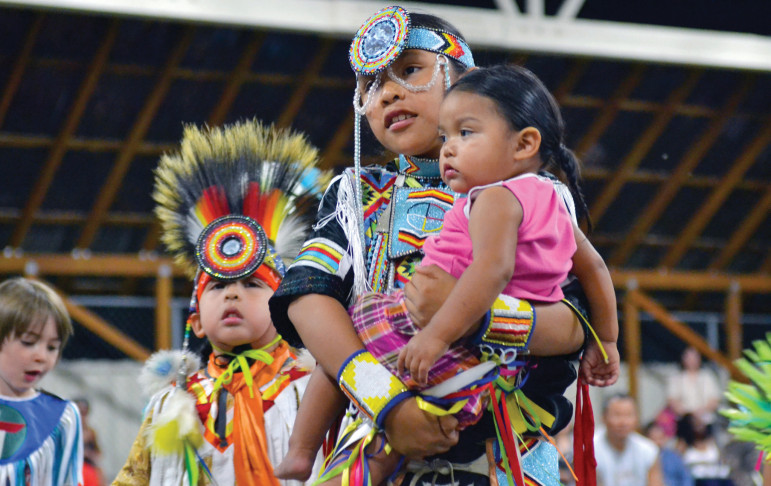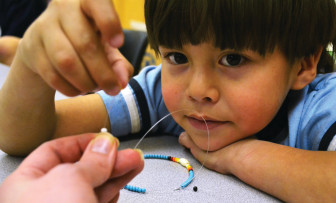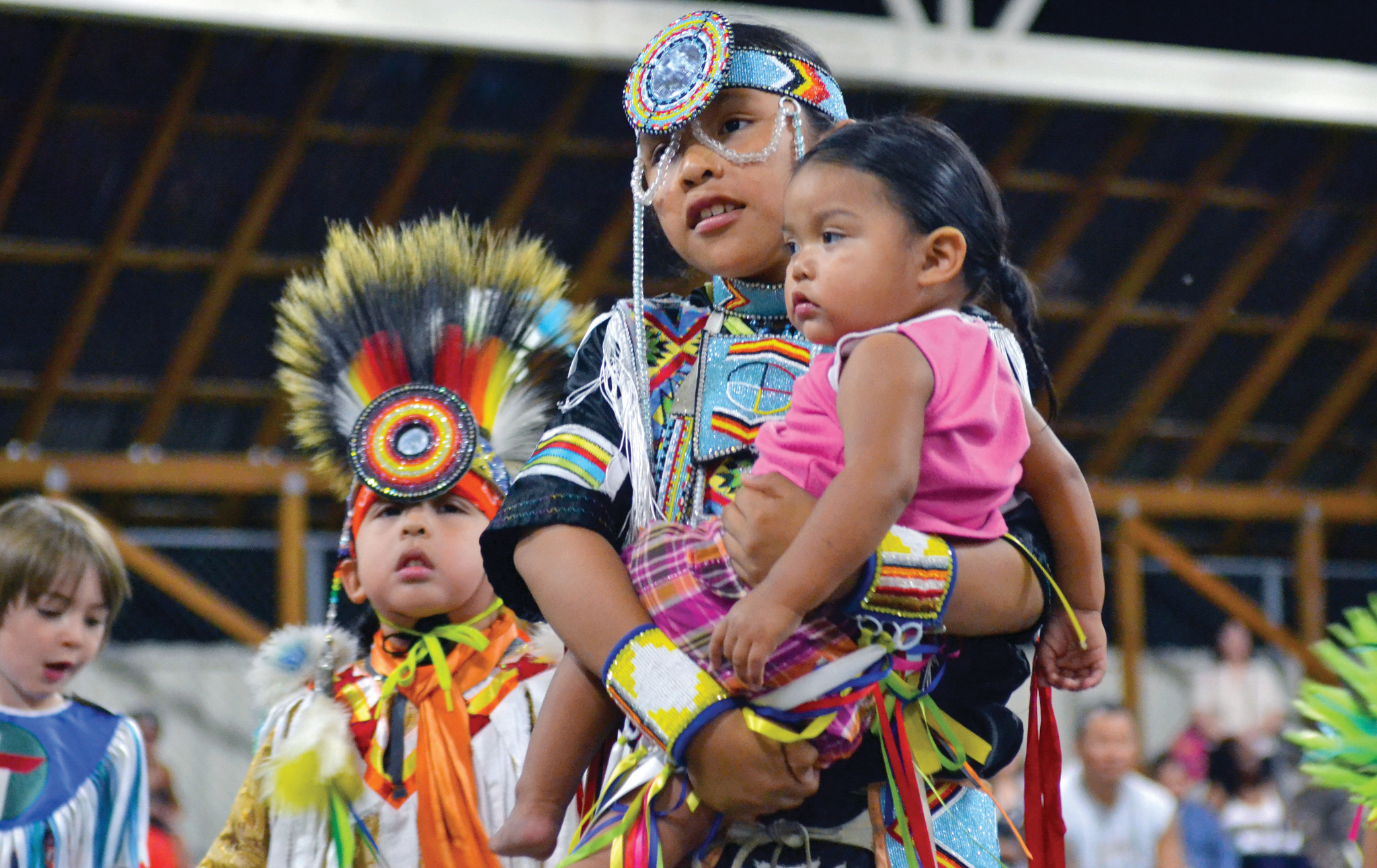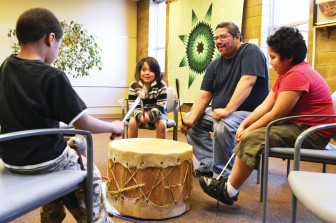
NAYA
The Native American Youth and Family Center (NAYA) celebrates the cultural identity of its youth and families. Here, children in traditional regalia take part in a powwow.
Every Monday night, families flock to the Native American Youth and Family Center (NAYA) in Portland, Oregon. Elders, parents and young people gather to have a meal and practice powwow drumming and dances. They work on crafts such as drum-making, moccasin-making or beading.
One evening this spring, a group of young women cut cloth to make cradleboards in which babies were traditionally carried. NAYA is committed to connecting local youth to their native culture.
NAYA is a 40-year-old organization that celebrates the multitribal heritage of Native Americans in the Portland area, offering numerous services. Last year, its staff of 120 served 7,000 families, said Oscar Arana, director of strategic development and communication.
“We work to build cultural identity,” said Ashley Thirstrup, NAYA’s assistant director of youth and education services. Young people become stronger when they become proud of who they are, she said. They are more likely to avoid problems such as drug addiction and they’re better able to deal with issues of race, she added.
Arana agreed. “Students have to be connected to their culture to be successful,” he said.
If they’re in a public school where their culture is invisible or not recognized, they don’t do as well. They do far better where it is “acknowledged and celebrated,” he said.
Canoes, shinny and working with elders
All the youth programs at NAYA, which include an afterschool program, Early College Academy, summer camps and a youth advocate program, find ways of connecting to traditional culture.
Last year, NAYA’s Youth & Elders Council greeted canoe paddlers taking part in an annual 11-day intertribal canoe journey of 95 miles. The Paddle to Quinault canoes arrived at Cathedral Park in Portland, and the council served a meal to them the next morning. The event inspired NAYA to create a canoe team to participate this year. Youth will pair with elders to learn from them about the tribal canoe journey and the significance of water in native cultures. One elder, Mary Renville, of the Sisseton Wahpeton Oyate tribe, spoke of a spiritual connection to water, but said the youth had lost it.
During spring break camp this year, kids learned the art of storytelling. Thirstrup said they read plays by native playwrights and played various tribal games, including shinny, which is similar to lacrosse. It’s “a really intense exciting game,” said Pierce Nelson, 17, an Oglala Lakota.
In summer camp last year, eighth graders worked on an elder biography project.
Social services, too
NAYA’s youth services include some more traditional social services, as well.
About 275 young people have a NAYA youth advocate. Kids in this case management program might work one-on-one with their advocate in an activity such as building a family tree, Thirstrup said.

NAYA
Beadwork and jewelry-making are skills that kids can learn at NAYA, which provides an afterschool program, summer camps and an early college academy, among its youth development programs.
NAYA also has a program for homeless youth and one for gang prevention, as well as services for foster families, since American Indian children are two-and-a-half times as likely to be in foster care than the population as a whole.
An Early College Academy, which serves 100 kids from five school districts, includes jewelry-making and other crafts in addition to academics.
Alexis Phillips, a Navaho, got involved NAYA when she was in middle school.
“I went through a period of my life when I was listening to what everyone else was saying I should be rather than figuring out what I really loved to do,” she said. NAYA helped her determine her own direction, she said.
The challenge of measuring effectiveness
With its focus on native culture, the big problem NAYA faced, however, was to measurably demonstrate its effectiveness. The organization felt increasing pressure as evidenced-based research came to play a larger role in social service agencies, including a funding requirement.
NAYA was skeptical of a measuring process that used narrowly defined outcomes and failed to acknowledge the whole spirit of a person. The process did not seem to be in keeping with a Native American worldview.
So NAYA’s leadership began looking for an assessment method that takes into account American Indian cultural values. The organization collaborated with the National Indian Child Welfare Association, a research, training, policy and development organization. A third partner was the University of Portland’s Research and Training Center on Family Support and Children’s Mental Health.
As part of the project, NAYA created focus groups composed of community elders, families, youth and NAYA staff. The groups were presented with several questions:
What does success look like for Native American youth?
What is necessary to help support youth in achieving success in their lives?
What are the conditions that hinder a youth’s progress toward success?
Out of these focus groups came a list of characteristics that members believed indicated the well-being of American Indian youth. The characteristics were rooted in Native American culture and contrasted with narrowly defined outcomes used to measure interventions.
For example, one narrow measure might be a student’s math score. Tribal elders agreed that high math scores could be a link to success in the dominant culture. But they said in their own community knowing appropriate cultural practices is more of an indicator of success.
The focus groups agreed that school achievement and reduced suicide rates were useful measures. But they considered the following eight indicators, representing values of the Indian community, equally important:
- Community-mindedness
- Positive cultural identity
- School belongingness
- Reduced perceived discrimination
- Hope
- Spirituality
- Positive relationships with adults
- Conflict resolution
Next, the partner organizations surveyed published research. They found links between these eight characteristics and commonly measured outcomes in research literature.
Community-mindedness, for example, was linked with lower rates of depression, less alcohol use and less antisocial behavior.
Positive cultural identity was linked to a number of desirable outcomes, including school success, increased resilience, lower alcohol and drug use and reduced prevalence of suicide.
Other research linked higher levels of hope with lower alcohol, tobacco and marijuana use.
Each characteristic defined by the community focus groups was found to be linked to common measurable outcomes.
New assessment tool
Now, when a young person becomes part of the youth advocate program, he or she will fill out an online questionnaire, Thirstrup said.
In addition to questions about drugs, alcohol and suicide, it asks: Do you feel safe in the neighborhood? How connected are you to a tribe? To an elder? Do you have traditional skills?
The assessment measures characteristics such as community-mindedness, positive relationships with adults and positive cultural identity.
It helps advocates understand a student’s needs, Thirstrup said, and it’s compared to an assessment done one year later.
“One of the strong leaps we’ve seen is in cultural identity,” she said. “Even with nonnative kids, this approach works well.”
NAYA is still in the process of measuring outcomes, but it is committed to a vision of thriving through connection to one’s roots.
Financial supporters of Youth Today may be quoted or mentioned in our stories. They may also be the subjects of our stories.































